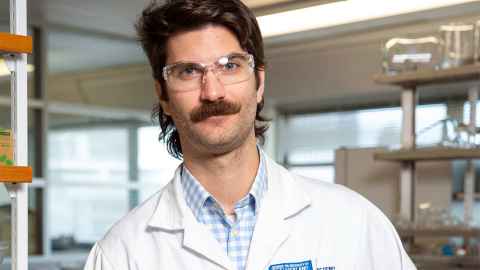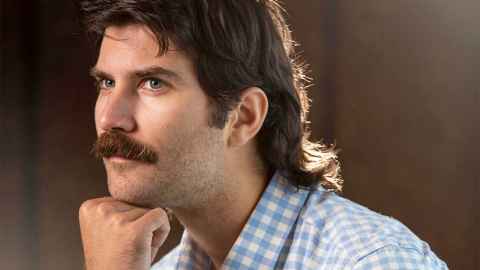Joel Rindelaub: comical chemical scientist hot on air quality
29 March 2021
'New Zealand's newest science celebrity' has a formula for getting his scientific messages across.

“The mullet, the moustache, the myth” proclaimed The Spinoff, although there isn’t a lot of myth to Dr Joel Rindelaub’s science.
It was his occasional not-so-scientific turn of phrase that got people talking when he appeared on TVNZ’s Breakfast. Discussing whether Covid-19 could be transmitted through a hotel’s ventilation system, he explained: “If you sneeze or you cough, you’re going to expel some gross droplets from your face hole, right?”
Joel and his ‘face hole’ interview went down a treat, if social media is the judge of anything. “I feel like I stepped back to Levin in the ’80s. That’s awesome,” tweeted one.
Joel has also been on RNZ talking about why masks should be used to cover that ‘face hole’. For that audience, he described the virus spreading through ‘the tiny droplets coming out of your mouth’ but threw in the word ‘spitball’ for good measure.
“I’m passionate about science communication so I adapt it for different audiences,” says Joel, a research fellow in the Faculty of Science. “Whether I’m doing chemistry demonstrations for primary school children, or talking about emissions with an older crowd, I try to fuel excitement in the kinds of things that we do at the University.”
Joel will have been in New Zealand four years on 15 April. He arrived on a working holiday visa, hoping to play a bit of ice hockey while here. Yes, ice hockey.
“There are five rep teams in the New Zealand Ice Hockey League, two in Auckland, one in Dunedin, one in Christchurch and one in Queenstown,” says Joel. “It’s a small community, but it’s very passionate.”
Joel played for the Botany Swarm at a rink in East Auckland and says the sport is popular amongst Canadian ex-pats. “So my accent has become more Canadian than Kiwi.”
That could also be something to do with where he’s from – Minnesota in northern US, on the border with Canada.
Anyway, he arrived to play ice hockey but had applied for the job at Auckland and secured it once he was here. “You could say ice hockey brought me here, but science is definitely the reason I’m staying.”
There’s little doubt Joel is part showman. In high school he won the Triple A award: for arts, academics and athletics, demonstrating his ability in all.
“Then I went to a small liberal arts university, Gustavus Adolphus College, in Minnesota. I wrote and performed in a play and also played ice hockey there. But I was a huge science nerd too.”
He settled into serious study, completing his PhD in chemistry at Purdue University.
“I worked in industry for two years and through that I realised my heart was definitely in academic research. I like learning and discovering and teaching.”
Chemistry is still at the heart of his research.
“Atmospheric chemistry, environmental chemistry and forensic science are my key focuses. I’m very interested in air quality.”
Recently, Joel highlighted the dangers of fireworks and his research was picked up by media.
“During Guy Fawke’s Day, it’s extremely common for people in New Zealand to light fireworks, randomly, in residential locations. They’re hanging onto sparklers in front of their faces. These have a high concentration of dangerous particles that you breathe in … but people just don’t think about it.
“I’m not the fun police. I’m not saying, ‘take away all fireworks’, but as a scientist, it’s my job to present this information, so people can make an informed choice.”
He also created a comedic YouTube video to emphasise his point further.
It’s perfectly normal for people to have questions, but it’s our job as scientists to propagate knowledge, rather than hide it.
Joel says New Zealand also has a problem when it comes to air quality.
In 2020, the government released a discussion document for its proposal to amend the National Environmental Standards for Air Quality (NESAQ), to address the size of particulate matter or PM. New Zealand’s air quality is strongly influenced by PM, which is measured in microns e.g. PM10, and smaller particles, PM2.5. The Cabinet paper says New Zealand is unusual in that the primary cause of particulate matter pollution is home heating in winter, followed by vehicle emissions, agricultural burning, industrial combustion and road dust. With home heating the dominant source of the pollution, 75 percent of New Zealand’s PM10 is actually the smaller unregulated PM2.5 particles.
In 2018 the estimated health effects attributable to PM2.5 particles were 646 premature adult deaths, 215 cardiac hospital admissions and 422 respiratory hospital admissions.
From 2014-16, 35 of 69 air-quality monitoring sites exceeded the NESAQ standard for daily PM10. In towns such as Alexandra, Arrowtown and Cromwell, the standards were exceeded more than 40 times in 2014.
“New Zealand is a long way behind Europe, the US and even China in how we regulate particulate matter,” says Joel. “The smaller the particle, the more dangerous, because it can go deeper into your lungs and cross into your bloodstream to your heart which pumps straight to your brain. That’s a risk factor for lung cancer and heart disease and it can affect cognitive ability as well.
“What the Ministry is proposing is to move from its current PM10 standard of 10 microns or less – that’s the diameter of the particle – and to finally regulate PM2.5. This is what all of the developed world did decades ago. The US did it in 1997, Europe around 2008, even China did it in 2013. This is how far behind New Zealand is.
“We just assume everything is pristine in this country which isn’t always the case. So we’re finally catching up to the rest of the world.”
He says the amendments to the regulations are expected sometime this year.
Joel is happy to talk about this to whoever needs to know and made a submission to the government on the proposed changes.
“Around 10 percent of my time is supposed to be focused on service so I definitely utilise that 10 percent because science communication is important. I started a YouTube channel over the first lockdown to try to convey science in a different manner. I try to communicate in a bit more of a light-hearted comedic fashion. It hasn’t really taken off, but it’s out there!”
Joel is also a freelance writer and used to write the science section in US pop culture magazine Paste. He recently had a piece in The Spinoff in which he clarified why the Covid-19 vaccine has been able to be developed quickly. It was written in response to a Herald article headlined: ‘Why I wouldn’t give son vaccine yet’ that questioned the safety of Covid-19 vaccines.
Joel responded: “In a piece that covers a significant breakthrough in science, you might expect to hear from an expert in the field, like a medical doctor or a PhD researcher. But not here. The only source was an accountant from Christchurch who was worried about the speed at which the vaccines were developed.”
Joel isn’t attacking people questioning the vaccine, but says scientists should have been called on to answer the questions.
“Money was the most significant factor that led to being able to expedite these vaccines. Scientists could start clinical trials as soon as they were ready and do parts of them simultaneously, simply because they didn’t have to worry about funding.
“It’s perfectly normal for people to have questions, but it’s our job as scientists to propagate this knowledge, rather than hide it. I wanted to correct that and educate at the same time.”

You could say ice hockey brought me here, but science is definitely the reason I’m staying.
Joel’s background is analytical chemistry and he “has a foot in the forensic programme too”.
“My projects try to marry forensic science, environmental chemistry and analytical chemistry. Every forensic scientist needs to understand analytical chemistry, which is basically how to measure chemicals. At a crime scene they need to understand exactly what’s there, on a molecular level. I teach some graduate level courses which are an introduction to forensic science, including environmental forensics.
“I also teach advanced analytical chemistry. The idea is to try to make classes fun and interesting so students are more engaged.
“Another of my interests is microplastics, not just in the air but in drinking water and various New Zealand beverages. And so, spoiler alert, yes they’re there, even in something like a takeaway container. There’s no such thing as microwave-safe plastics either, it’s just that some are better than others.”
He says science updates and amends information as it discovers more. An example might be that early in Covid-19 we were told the virus wasn’t airborne, then that it was.
“This is a completely novel virus, we knew virtually nothing about it. So, our knowledge is going to grow and change and that’s the beautiful thing about science. If we’re wrong about something we correct it. It’s a constant learning process.”
He says the University is fortunate it has a number of people who excel in science communications.
“As well as Siouxsie Wiles and Shaun Hendy, who we’ve come to know through Covid, there’s Professor Richard Easther. I’m not a physicist, but he’s able to break down really complex astrophysics and make it more understandable. That’s a very underrated part of this University; that we have really smart people who are able to connect with different audiences.”
Back to the important stuff – the mullet, the moustache and the manner. Is this is a look he fosters to reflect the comedic aspect of his personality?
“I’ve had a mullet on and off since high school. It’s been a full-time thing since 2013. In ice hockey they call it ‘the flow’ because it just comes out the back of the helmet … and kind of waves like a cape. If you look at the 90s, it was a popular haircut for many professional ice hockey players. Then I got used to it, and now I just roll with it.”
Joel doesn’t have family here but his parents visited when that kind of thing was allowed and they love it here. He didn’t expect to be in New Zealand this long but has a contract until 2023.
“I enjoy New Zealand, I love to go tramping or just get out into the bush. I don’t mind being stuck here.”
Asked if there’s anything else he wants to add, his message is simple: “Just that science is awesome.”
Denise Montgomery